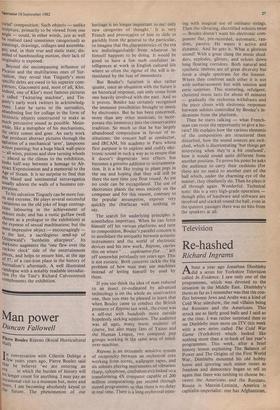Art
Suisside
John McEwen
The retrospective of Jean Tinguely's motorised sculpture comes to the Tate Gallery (till 28 November) from the Musee d'Art et d'Histoire in Geneva, where an at- tendance of about three-quarters of a million made it the most popular exhibition in the history of Switzerland. No doubt past of the reason for this spectacular success is that Tinguely is Swiss, and an away game will probably bring down the crowd; never- theless, for an exhibition of modern art, it unquestionably has a rare popular appeal. Children will enjoy it because there are a lot of buttons to press, grown-ups because it will make them feel like children again' hobbyists because it tinkers about with mechanics, highbrows because it has an ar- tistic pedigree. It is therefore both fun and metaphorical. It is this metaphoricalness, combined with the salt of some satire, that places these machines in an art museum and quite apart from the whimsical fun and folderols of those built by our own Rowland Emett. If Tinguely has an artistic equivalent in this country it is the inimitable Bruce Lacey, who played a role in Tinguely's notorious debut performance at the ICA in 1959. Some may gratefully recall a Lacey-inspired theatrical entertainment called An Evening of British Rubbish, back in the early Sixties. It was funnier than a Tinguely event, because it was more anar- chic, but Tinguely's work is of the same genre. This genre, at least in its 20th-century form, is Dada. The anarchy of Dada can be interpreted as an expression of individual powerlessness felt in the blackest days of the Great War. A similar sense of power- lessness against the Bomb undoubtedly con- tributed to the Dada revival in the Fifties, of which Tinguely formed a part. The Fif- ties, too, saw the dawn of micro awareness. A molecular structure famously stir mounted the Brussels World Fair as the symbol of the time. Tinguely's desire to make objects that move, his repeated belief, in such notions as 'the monster of stability and 'the only stable thing is movement: speaks of the same awareness. His sense of powerlessness, recognition of organic flux' belief that the only certainty in the world is uncertainty, found perhaps their most logical expression in machines that destroyed themselves. However, to find the work of such a believer in change and trail' sitoriness shored up in museums against Time's ruin proves to be less contradictorY than might be supposed. The work of his popularity guys, whimsically, nostalgically and playfully, old-fashioned ideas 01 mechanical logic; but a fair proportion of the rest is far more art conscious, With movement secondary in importance to 'Pic-
torial' composition. Such objects — unlike sculpture, primarily to be viewed from one angle — could, in other words, just as well be realised (and sometimes categorised) as Paintings, drawings, collages and assembla- ges; and, in their true and static state, dis- pelled of bamboozling motion, their lack of originality is exposed.
Beyond the encompassing influence of Picasso and the multifarious ones of Sur- realism, they reveal that Tinguely's most specific debts are owed to his superior com- patriots, Giacometti and, most of all, Klee. lndeed, one of Klee's most famous pictures Is called 'Twittering machine', and Tin- guely's early work twitters in acknowledg- ment. Later he turns to the surrealists, abandoning line for collage in the form of fetishistic objects constructed to make as much percussive sound as possible. Mean- while, like a metaphor of his mechanisms, the satire comes and goes. An early work that produces abstract pictures through the agitation of a mechanical 'arm', lampoons action painting; but a huge black wall-piece
all wires, pistons and slow turning wheels
placed as the climax to the exhibition, looks half-way between a homage to Ab- stract Expressionism and a memorial to the Age of Steam. It is no surprise to find that this bland and sentimental extravaganza usually adorns the walls of a business cor- Poration.
To his salvation Tinguely can be more fun- ny and extreme. He plays several successful variations on the old joke of huge contrap- tions labouring in the achievement of Minute ends; and has a rustic guffaw (well Chosen as a prologue to the exhibition) at the expense of ,sexual machination; but the most impressive object encouragingly — Is the last, a sacrilegious send-up of Grtinewald's `Isenheim altarpiece'. Its darkness augments the 'one flew over the cuckoo clock' side of the entertainment Pieces, and helps to ensure him, at the age of 57, of a cast-iron place in the history of Surrealism's aftermath. A well illustrated catalogue with a notably readable introduc- tion (by the Tate's Richard Calvocoressi) Complements the exhibition.



































 Previous page
Previous page